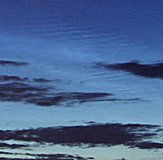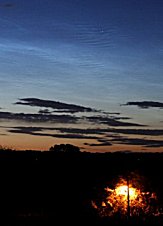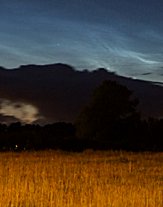| |
Observing
tips: Look
west 30 to 60 minutes after sunset when
the Sun has dipped 6o to 16o below the horizon.
If you see luminous blue-white tendrils spreading across the sky,
you've probably spotted a noctilucent
cloud. Although
noctilucent clouds appear most often at arctic latitudes, they have
been sighted in recent years
as far south as Colorado, Utah and Virginia. NLCs are seasonal,
appearing most often in late spring and summer. In the northern
hemisphere, the best time to look would be between mid-May and the
end of August. See also 2003,
2004, 2005,
2006, 2007,
and 2008 |
 |
| |
| |
Photographer,
Location |
Images |
Comments |
|

|
Lars
Zielke,
Nightsky Observatory, Tvis, Denmark
Jun. 9, 2009 |
#1,
#2, #3 |
Just
after midnight on June 9 there was some beautiful NLC to
the north, seen from my location in Denmark. I took some
wide field and close up photos of the NLC's from 00:30 to
01:00 local time. I've have made some small movies that
shows how the clouds are changing: more. |
|

|
Paul
Evans,
Larne, Northern Ireland
Jun. 11, 2009 |
#1,
#2, #3,
#4, more |
This
display started to become apparent at midnight and lasted
almost three hours until the oncoming dawn drowned it out.
Display was interspersed with lower clouds and in terms
of NLC forms was not very structured though various patterns
could clearly be seen. Pictures taken with Minolta Dimage
A2 camera with intervalometer function, Aperture priority
auto, f3.5, ISO200 |
|

|
John
C McConnell,
Maghaberry Northern Ireland.
Jun. 11, 2009 |
#1,
#2,
#3,
#4 |
Hi
Tony,after a drought of a few nights the NLC's returned
last night June 10/11.Included were again some forms I have
never seen before.Below Capella was a row of 'holes' and
to the east thereof some circular patches of 'ripples'.
You can certainly see where the term "electric blue" came
from.These images are all untouched except for resizing
and are in the order of 8-10 seconds on ISO800.
Photo
details: Canon 400D 18-55mm lens. |
|

|
Martin
Mc Kenna,
Maghera, Co. Derry, N. Ireland
Jun. 11, 2009 |
#1,
#2,
#3,
#4,
more |
After
a long break with no further NLC displays, the Mesosphere
finally produced another after midnight last night. This
one was 80 degrees long with the classic, but always welcomed,
electric blue colours which then turned silvery-white later
in the night. The highlight of the display was the large
cluster of herringbone structure which really did look like
'sand ripples on a beach at low tide' before dawn below
the flickering beacon of Capella. Nice display.
Photo
details: Fujifilm S6500fd 6.3MP various settings
|
|
|
|





